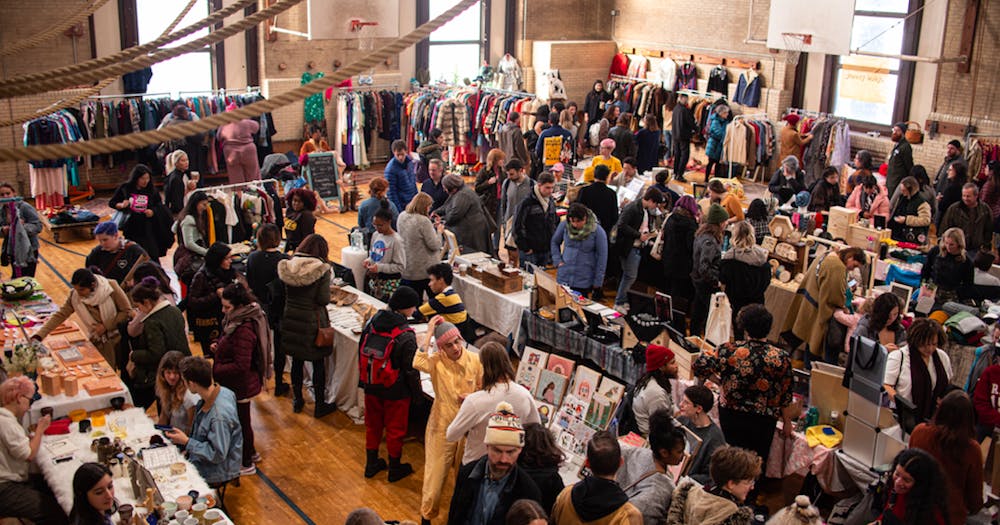If you’re into polymer clay earrings, sustainable crochet, stunning watercolor portraits, and everything in between, the Feminist Flea Market & Craft Fair is the place to be.
First organized in 2018, the market is dedicated to highlighting artists marginalized for their gender, including women and transgender, non–binary, and gender non–conforming folks. Funds generated at the Feminist Flea also go directly towards local community organizations throughout the city.
The market had its most recent openings outdoors and in person after conducting their event virtually last year. Feminist Flea's first “nighttime market” of 2021 was in late August at Cherry Street Pier, with its donations benefiting Homies Helping Homies, a mutual aid distribution effort in Point Breeze. The event garnered over $6,000 for the organization’s shopping fund, helping them buy supplies for their biweekly food and household item distribution. The fair’s most recent appearance was as a complementary “daytime market” in the parking lot of Love City Brewing last Saturday, with $3 of the $5 entry fee going towards the Coalition for Black Trans Economic Liberation. Each market had over 40 amazing, non–repeating vendors present.
Reb Aronow, the organizer of the Feminist Flea Market & Craft Fair, says they are intentional about choosing artists for the event—specifically prioritizing vendors that are Black, Indigenous, people of color, trans, and queer.
The market has been committed to this mission for years, but it’s also evolved in many ways since its inception. “I think every day, month, year, I get more and more radical,” Aronow says, “[and] I think that has shown itself in the market.” They explain that implementing a robust feedback form for vendors has allowed for more community input into the market, and ultimately helped bring about initiatives like a sliding–scale vendor fee system.
Previously, if vendors could not afford the market’s vendor fee, they would have to reach out to set up a separate payment plan. While Aronow offered this flexibility, they acknowledged that this system may have deterred people from vending at all, and didn’t fully consider people’s financial capacity or variations in the amount vendors would make based on their differently–priced products. Now, Feminist Flea has shifted to a sliding–scale system that allows vendors to choose what they are comfortable paying on a given spectrum, no questions asked. The fee range depends on the particular market’s venue costs and budget, so Aronow also offers the ability for vendors to pay in increments, pay less than the bottom range, or not pay at all—with a consideration for what is financially accessible to the vendor.
Another significant change in the market’s operation was directing money to grassroots and mutual aid organizations rather than to nonprofits. Through their experience working in the nonprofit industry and witnessing the intense harms of the nonprofit industrial complex, Aronow realized that it did not make sense for the Feminist Flea Market to funnel money in that direction. Instead of treating donations as a one–time event, the market now focuses on building sustainable and reciprocal relationships with organizations that look to meet the needs of their community.
Last February, the Feminist Flea collaborated with Philly Red Umbrella Alliance and Project SAFE for their Philadelphia Sex Worker Relief Fund, two organizations Aronow says are constantly in dialogue with the community that they’re serving. Learning about the work of the organization, directing volunteers, and signal–boosting requests for resources are a few ways the Feminist Flea hopes to build upon these connections.
Aronow is also hopeful for potential collaborations with community groups they’ve worked with in the past, “especially given that so many people who run community orgs are also artists. There are so many interesting ways that we can cross collaborate.”
Within the Feminist Flea Market itself, Aronow stresses that it’s important for the market to feel safe for people at the intersections of marginalized identities. “I believe in time and space for connection, joy, and reciprocal support ... There's something about having a space for art made by people that are acknowledging the systems we’re trapped in, and therefore trying to break out of,” Aronow says. They ultimately want the market to align with their values, and the values of the people who come to the market—aiming to redistribute wealth, and giving people the opportunity to be intentional about where they spend their money.
For Aronow, however, there’s always room to learn, grow, and change. The future of the Feminist Flea Market & Craft Fair is something they think about often: "What are the ways the market can—even though 'it's just a market'—keep pushing boundaries?" In whatever form this may take, the market is resolved to celebrating the Philadelphia community in radical ways, and consistently showing up for one another in solidarity.
While the market recently had its last 2021 appearance on Sept. 25, you can visit the Feminist Flea website to look out for its next event, as well as a list of all the previously featured vendors.

